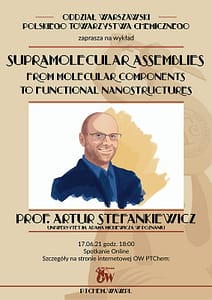Samoorganizacja supramolekularna- od cząsteczek do funkcjonalnych nanostruktur
Artur R. Stefankiewicz
17 czerwca, godz. 1800, wykład on-line:
SUPRAMOLECULAR ASSEMBLIES – FROM MOLECULAR COMPONENTS TO FUNCTIONAL NANOSTRUCTURES
Artur R. Stefankiewicz1,2*
1 Faculty of Chemistry, Adam Mickiewicz University in Poznań, Poland;
2 Centre for Advanced Technologies, Adam Mickiewicz University in Poznań,
* Corresponding author and presenter: ars@amu.edu.pl
Supramolecular chemistry investigates chemicals systems and large architectures build from simple molecular components connected via weak, non-covalent and reversible interactions. The same holds for molecular chemistry when the molecular entity contains covalent bonds that may form and break reversibility, so as to allow a continuous modification in constitution by reorganization and exchange of building blocks. These features define a Dynamic Combinatorial Chemistry (DCC) on both the molecular and supramolecular levels.1The field of DCC is currently undergoing a revival, largely on account of our increased understanding of supramolecular phenomena and the subsequent development of self-assembly processes. The results obtained so far show the enormous potential of complex and functional chemical systems generated by implementation of supramolecular and DCC approach, however the full understanding of controlled synthesis of multicomponent molecular and supramolecular architectures (2D and 3D), with predicted physicochemical parameters was not yet achieved.
Taking into account the big potential of supramolecular and dynamic covalent chemistries in the creation of functional architectures2 we decided to investigate the formation of complex chemical systems by means of dynamic/reversible covalent and non-covalent bonds.3 The purpose of our studies is the development of new complex supramolecular and molecular dynamic systems of different topologies and functions.4,5 The influence of the employed dynamic bonds on the structural, physicochemical and functional properties of the synthesized architectures is of our main interest.
References:
- Black, S. P.; Sanders, J. K. M.; Stefankiewicz, A. R.; Chem. Soc. Rev., 2014, 43, 1861.
- Gorczyński, A.; Harrowfiled, J.; Patroniak, V.; Stefankiewicz, A.R.; Chem. Rev. 2016, 116 (23), 14620.
- Markiewicz, G.; Smulders, M. M. J.; Stefankiewicz, A. R.; Adv. Sci. 2019, 6, 1900577
- Kołodziejski, M.; Stefankiewicz, A. R.; Lehn, J.-M.; Chem. Sci., 2019, 10, 1836-1843
- Markiewicz, G.; Jenczak, A.; Kołodziejski, M.; Holstein, J.J.; Sanders, J. K. M.; Stefankiewicz, Nat. Commun., 2017, 8, 15109.

